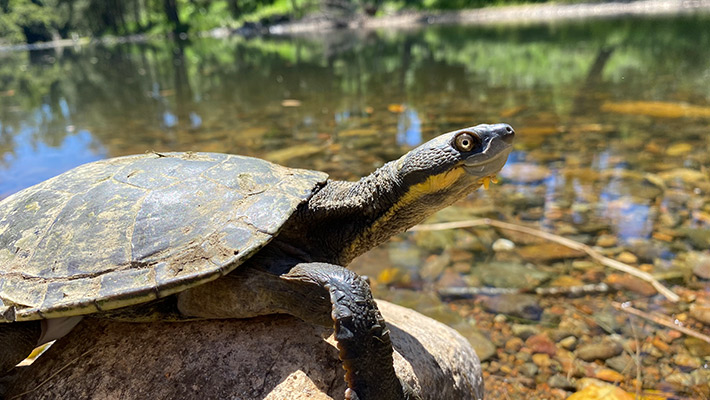Learn about the Bellinger River Turtle
Scientific name: Myuchelys georgesi
Classification: Critically Endangered
Size: Shell length 18cm for males, 25cm for females
Distribution: Bellinger River in Northern NSW
Habitat: Freshwater rivers, preferring deep and rocky waters
Lifespan: Around 29 years
Clutch size: 10-16 eggs
Incubation: 72 days
Primary Threats: Disease, introduced predators, water quality, habitat changes, hybridisation and competition with the Murray River Turtle
What do Bellinger River Turtles eat?
Bellinger River Turtles mostly eat macro-invertebrates found in the bottom of the river, but also eat some underwater plants and fruits from on land. As scavengers, they play an important role in keeping river systems healthy and clean, and cycling nutrients.
Bottom Breather
This freshwater turtle can breathe through its bottom, a process known as cloacal respiration. This allows it to swim in deeper water without needing to return to the surface as frequently.
Turtle Pandemic
In 2015, a pair of canoeists found distressed and dying turtles, suffering blindness and lesions, and succumbing to organ failure. Taronga’s scientists from the Australian Registry of Wildlife Health helped determine the cause to be a previously unknown virus. It caused a mass mortality event, wiping out around 90% of the population in just six weeks.
Emergency Response
When the viral outbreak was detected, Taronga launched into action. Working with the NSW state government and other specialists, Taronga collected 16 healthy turtles to establish a recovery program. In 2023, a purpose-built breeding facility was opened at Taronga Zoo that includes 40 tanks for rearing turtles, and special hatching facilities.
Return to the River
Our program has already proven successful, with over 200 hatchlings emerging across five successive breeding seasons. These hatchlings have allowed for five releases into the river to date, with 197 young turtles now returned. Post-release monitoring of turtles is underway to continue improving survival.
Predator Protection
Bellinger River Turtle eggs are sometimes eaten by Goannas whilst hatchlings can fall prey to catfish, both native to the area, however a non-native predator is now causing the greatest risk. Foxes are a widespread pest in Australia, and short-necked turtles are particularly vulnerable as they cannot fully retract their heads and limbs into their shells. Controlling fox populations and protection of nesting sites are critical to long-term recovery.
